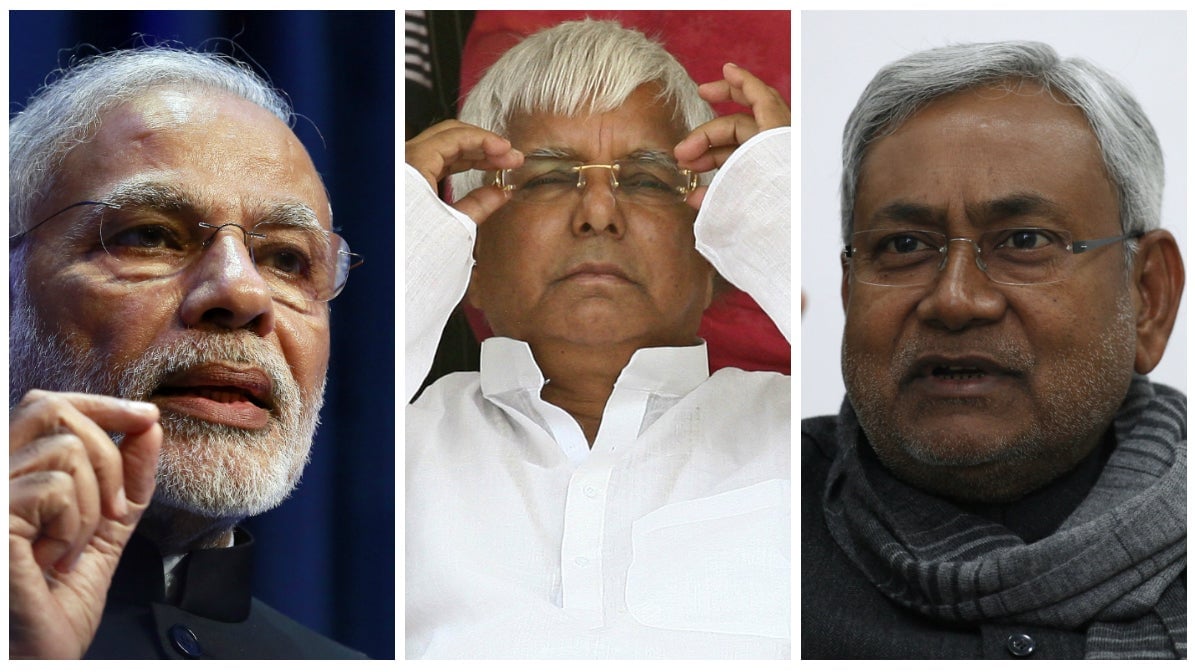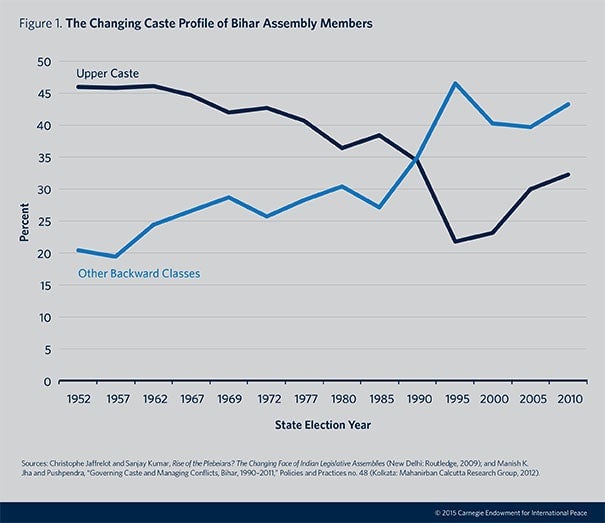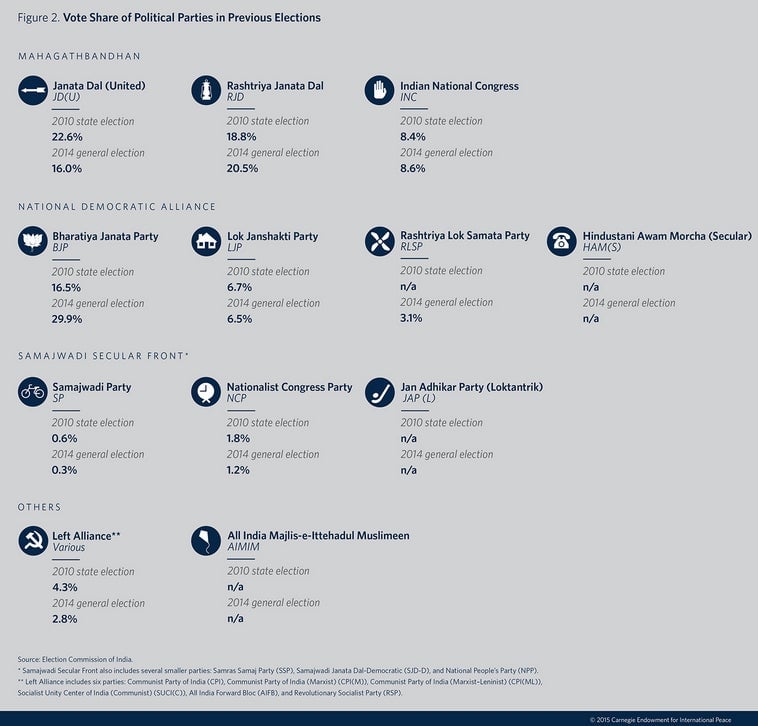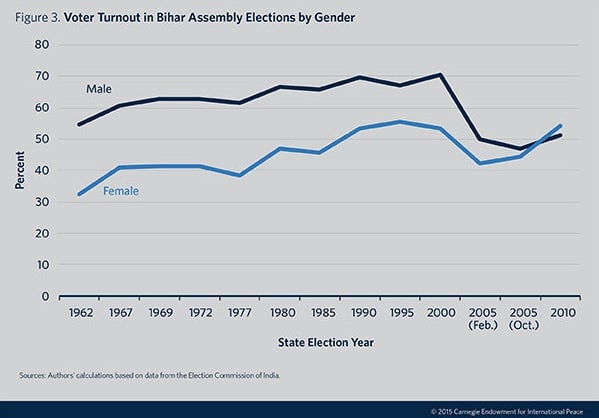A complete guide to the Bihar elections
This post first appeared on Carnegieendowment.org.


This post first appeared on Carnegieendowment.org.
Over the course of four weeks in October and November 2015, voters in the Indian state of Bihar will elect their next state government. In India, which has a staggered calendar of state and national elections, another poll is always right around the corner. Yet the upcoming vote in Bihar is widely seen as a referendum on the 16-month-old national government of the Bharatiya Janata Party (BJP) and prime minister Narendra Modi.
Politics in Bihar can confound even veteran political observers thanks to fluctuating alliance dynamics, complex caste arithmetic, and political fragmentation. Yet there are still distinct trends shaping what has been called the “mother of all elections” by the country’s chief election commissioner.
Why Bihar matters
The contest in Bihar is attracting an unusual amount of attention for a regional election because of the state’s size and the verdict’s broader political ramifications.
For starters, Bihar is home to 104 million Indians as of 2011—making it the country’s third most populous state. Accounting for 8.6% of India’s population and an area that is approximately the size of Hungary, Bihar matters on these grounds alone. Because India’s states conduct most day-to-day governance tasks and the public sector remains deeply enmeshed in the functioning of the economy, wrestling control of the state provides the winner with significant political power.
A corollary of Bihar’s size is its influence in India’s federal power structure. The state elects 40 members out of 545 to India’s lower house of parliament (the Lok Sabha) and 16 members out of 245 to the upper house (the Rajya Sabha). The BJP currently commands a majority of seats in the former but only a minority of seats in the latter. However, if the BJP government is to successfully implement its legislative agenda, it requires the assent of both houses for most bills. Rajya Sabha members are indirectly elected by members of the various state assemblies, making control of those state bodies critical if the ruling BJP is to cobble together a majority in the upper house. Before the Modi government’s first term expires in May 2019, eleven of Bihar’s sixteen Rajya Sabha seats will become vacant—a significant opportunity for the BJP to make up representational ground.
Since coming to power in May 2014, the BJP has won several regional votes, raising the number of states under its control to eight—an all-time high for the party. The BJP’s impressive run abruptly ended in February 2015, when it was stunned in the Delhi state election by the Aam Aadmi Party. The Bihar election will clarify whether Delhi was an aberration or the dawn of a new trend. Further fuelling the notion that the Bihar election will serve as a vote of confidence in the central government, the BJP alliance in Bihar has refused to name a chief ministerial candidate, choosing instead to make Modi the face of the campaign.
The outcome in the Bihar election will also shape the political fortunes of incumbent Bihar chief minister Nitish Kumar of the Janata Dal (United), or the JD(U), who is hoping to serve a third term as the state’s top leader. If Kumar can emerge victorious, he will cement his status as one of the nation’s most prominent opposition leaders. In his quest, Kumar has rallied to his side several major parties opposed to the BJP, creating a formidable alliance.
Finally, this election will test the proposition that the BJP juggernaut can be stopped if forces opposed to it forge a united front. In India’s winner-take-all electoral system, a fractured opposition that fails to coordinate risks dividing the anti-BJP vote—inadvertently aiding the BJP’s rise. If, however, the anti-BJP front prevails in Bihar, it could offer a template for future assembly elections.
Shifting political coalitions
Bihar’s politics are notoriously difficult to decipher thanks to constantly changing alliances, political fragmentation, and the underlying caste arithmetic that motivates political allegiances. These factors are deeply interrelated as parties have distinct caste bases (or vote banks) that can also change over time. In religious terms, Hindus constitute 83% of the state’s population and are further subdivided into three major caste groupings: upper castes, backward castes (also known as other backward classes, or OBCs), and Dalits (also known as scheduled castes). Dalits comprise 16% of Bihar’s population, upper castes account for between 15% to 20%, and OBCs constitute approximately 50% (see note 1). The Muslim-minority community makes up the balance of the population, roughly 17%.
To simplify matters, Bihar’s trajectory after India gained independence from the UK can be divided into four phases.
From 1947 to 1967, the Indian National Congress was the dominant player in Bihar. While the catchall Congress claimed to represent a diverse mix of demographic constituencies, its representatives largely hailed from the Hindu upper castes. Although upper castes accounted for less than one-fifth of Bihar’s population, they initially comprised nearly half of its legislative representatives (see figure 1). In contrast, OBCs constituted a near majority of residents in the state but a disproportionately small fraction of its political class.

In 1967, a non-Congress government—propelled by the growing political clout of OBCs—came to power in Bihar for the first time. Indeed, the proportion of OBC state legislators grew by nearly 10 percentage points, hitting almost 30% in 1969. However, the lack of clear governing majorities led to several decades of political instability. Although the Congress’s luster was badly tarnished, its persistent hold on power in Delhi and the depth of the opposition’s fragmentation allowed it to maintain the upper hand in the state for most of the period until 1989.
A third phase was ushered in when the opposition Janata Dal, a precursor to a host of backward-caste parties like the JD(U), stormed to power in 1990 behind a wily politician, Lalu Prasad Yadav, who was one of several backward-caste leaders in India to receive a boost from a government commission that advocated civil service and educational quotas for OBCs, not to mention the resulting upper caste backlash. Exploiting these fissures, Yadav stitched together a formidable coalition of backward castes and Muslims to maintain political power for a decade and a half. Yadav’s core political base consisted of his own Yadav community, the most politically and economically successful subgroup of the OBCs.
In 1990, for the first time in the state’s history, OBCs outnumbered upper castes in the state assembly, a trend that persists. Although Yadav stepped down in 1997 amid corruption allegations, he installed his wife, Rabri Devi, as chief minister. Along the way, the Janata Dal split, with Yadav and Rabri Devi forming the Rashtriya Janata Dal (RJD) and their rival, Nitish Kumar, forming the JD(U).
By 2005, the popularity of the RJD government had sharply declined, heralding the fourth phase of the state’s politics. The party’s fifteen-year rule witnessed a decline in the quality of governance, characterized by slowing growth and a breakdown in law and order. In October 2005, an alliance of the BJP and JD(U) was elected into office, propelling JD(U) leader Kumar into the post of chief minister.
The BJP-JD(U) alliance forged a powerful political coalition that exploited the BJP’s popularity among Hindu upper castes and the JD(U)’s constituency made up of the lower rungs of the OBCs, a new grouping that came to be known as extremely backward castes (EBCs). The construction of the EBC identity was a savvy attempt to strip votes of non-Yadav backward castes from the RJD. Kumar’s JD(U) also fractured the vote of Bihar’s Dalits by again targeting the most backward among them, fashioning a new Mahadalit category and directing welfare benefits to this new group.
The BJP-JD(U) alliance won the October 2005 election and, on the strength of its caste calculus and development-centric rhetoric, handily won reelection in 2010. However, the coalition abruptly fell apart three years later, when Kumar broke with the BJP over its decision to name Modi the party’s prime ministerial candidate for the 2014 general election. After the JD(U)’s shambolic performance in the national poll (it won just two of Bihar’s 40 parliamentary seats), Kumar resigned as chief minister. In February, Kumar moved to reoccupy his former post, prompting his replacement, Jitan Ram Manjhi, to quit the JD(U) and form his own political party, the Hindustani Awam Morcha (Secular).
Heading into the 2015 election, alliance dynamics has again shifted (see figure 2). Three parties—the JD(U), the RJD, and the Congress—have joined forces to counteract the growing influence of the BJP. This grand alliance, or Mahagathbandhan, was made possible by a marriage of convenience between two erstwhile rivals, Kumar and Yadav, who realized a rising BJP placed their political futures at risk. The Congress is now a bit player in Bihar politics, claiming only four seats in the current assembly, but its marginal vote share can play an outsized role in a deeply fragmented election. In the May 2014 general election, these three parties failed to coordinate, effectively dividing the anti-BJP vote and damaging their prospects.
Seeking to dislodge this grand alliance is a coalition of parties led by the BJP, collectively known as the National Democratic Alliance. This grouping also includes the Lok Janshakti Party, the Rashtriya Lok Samata Party, and the Hindustani Awam Morcha (Secular)—smaller regional parties that are each associated with a distinct, caste-based vote bank.

Three trends to watch
Given these complex dynamics, the best one can do when it comes to predicting election outcomes in Bihar is point to important factors that help shape the results. There are three in particular that merit mention.
First, one increasingly resonant trend is the importance of governance and development in voter evaluations. By 2005, nearly half of Bihar’s voters felt that security had worsened during the preceding fifteen years while nearly two-thirds negatively evaluated the condition of roads and the availability of electricity. The souring economy and state of governance under fifteen years of RJD rule, during which per capita income in Bihar actually declined, allowed the BJP-JD(U) alliance to centre its 2005 campaign on the pledge that it would reverse this decade and a half of “Jungle Raj” with “Vikas Raj” (vikas means development in Hindi). This promise, and its partial realisation, delivered handsome electoral rewards. Pre-election surveys have clarified the link between good governance and popular perceptions of the ruling alliance and have emphasised the critical role development issues—namely, electricity, unemployment, and inflation—continue to play in the mind of the Bihari voter.
While Bihar remains India’s poorest state, Kumar’s efforts to roll out targeted welfare schemes, increase infrastructure spending, and improve law and order have paid economic dividends. Today, Bihar is one of the fastest-growing states in India (aided, in part of course, by a low starting point). In 2014–2015, per capita income in Bihar grew at 8.4%—making it the second-fastest-growing state in India (see note 2).
The question is whether voters—their aspirations piqued by Bihar’s recent economic upturn—remain satisfied with the pace of change or, instead, feel that Modi’s BJP offers them a brighter future. Heading into the election, the BJP is touting Bihar’s progress during the eight years it was part of the ruling alliance while claiming that those gains were squandered when Kumar chose to dissolve the BJP-JD(U) coalition in 2013, placing politics above his state’s own interests. Several recent polls have suggested that many voters agree; voters have regularly rated the performance of the Bihar government higher when the BJP was a principal member. The BJP is also making much of the fact that Kumar’s pact with Yadav’s party will return Bihar to its Jungle Raj days by forsaking aspirational politics in favour of parochial caste calculations.
Second, demographic shifts have introduced fresh uncertainty. Traditionally, men in Bihar have been significantly more likely to vote when compared to women. In 1962, total voter turnout in Bihar stood at 44%; however, this aggregate number masked considerable variation. Male voter turnout was 55%, more than 20 percentage points above female turnout (32%). That gap remained for the next three decades, before narrowing in the 1990s. By 2005, the differential in voter turnout between men and women reached single digits. In 2010, female turnout outpaced male turnout for the first time (see figure 3).

Researchers have argued that this shift has been pivotal in determining political outcomes in recent state elections, with women playing an especially critical role in the RJD’s 2005 ouster. Whether women are content with the gains made during Kumar’s rule or instead wish to give a new party a chance is a question analysts are intensely scrutinising.
Young voters are also important when it comes to demographics. Out of an electorate of nearly 67 million eligible voters, almost 31% are between the ages of 18 and 29. The BJP’s ability to cater to younger voters through its messaging, social media, and projection of Modi as a leader in touch with India’s youth was instrumental in establishing the party’s dominance in 2014. One study found a stark correlation between changes in the BJP’s electoral fortunes and the share of first-time voters, those between the ages of 18 and 23. The ability of the BJP alliance to recapture the political imagination of young voters, and to mobilise them to turn out, will be key to its success.
A final factor pertains to the swings in parties’ caste support bases. Traditionally, each of the major parties has relied on distinctive vote banks. On the anti-BJP front, the RJD has attracted votes from the Yadav and Muslim-minority communities. Because the Congress—the other party with strong Muslim support—is allying with the RJD, the anti-BJP coalition is poised to sweep the Muslim vote. According to data from the Centre for the Study of Developing Societies, the BJP alliance only earned 2% of the Muslim vote in Bihar in the last general election. The JD(U), for its part, has profited mainly by targeting EBCs and Mahadalits (see note 3).
For the National Democratic Alliance, the upper caste vote (78% of which went to the BJP alliance in May 2014) is likely to stay loyal. Each of the BJP’s alliance partners represents a key community that adds to this base: the Lok Janshakti Party’s base is among the Paswans, one of the most significant Dalit castes, while the Rashtriya Lok Samata Party claims to represent the Koeri community, an important OBC caste. Hindustani Awam Morcha, as previously noted, seeks to carry the Mahadalit vote.
When it comes to doing the caste math, three wild cards deserve closer scrutiny.
While data from the Centre for the Study of Developing Societies indicate that 76% of the Yadav vote collectively accrued to the RJD, the Congress, and the JD(U) in the 2014 general election, the recent defection of key legislator Pappu Yadav from the RJD has raised fresh doubts about the anti-BJP coalition’s monopoly of this group’s votes. Pappu Yadav has joined hands with a group of smaller parties unaffiliated with either major alliance, instigating rumors that he has struck a tacit understanding with the BJP to divide the anti-BJP vote in his area of influence.
Another wild card is the Dalit vote. Kumar’s ability to carve out a Mahadalit identity was a key component of his past electoral success. If the National Democratic Alliance can occupy this ground, thanks to its embrace of former chief minister Manjhi’s Hindustani Awam Morcha (Secular), it will eliminate a major source of support for the anti-BJP alliance.
A final wild card relates to a spate of minor players, each with a small vote share but the potential to play spoiler. Chief among these spoilers are the Left parties, six of which recently announced a grand alliance. Other spoilers to look out for include the Samajwadi Party, the Nationalist Congress Party, and the All India Majlis-e-Ittehadul Muslimeen (AIMIM). The Samajwadi Party and Nationalist Congress Party, once members of the anti-BJP alliance, recently announced their plans to contest the Bihar election as part of an alternative anti-BJP front (which includes Pappu Yadav’s fledgling party). While these two parties have limited presences in Bihar (collectively, they earned just 2.4% of the vote in Bihar’s 2010 assembly election), their decision to go a different route risks dividing the anti-BJP vote.
The rising popularity of the AIMIM is one of the most interesting developments in contemporary Indian politics. With strong roots in the city of Hyderabad, the AIMIM has begun expanding beyond its narrow geographic domain. The AIMIM will likely contest 24 seats in Bihar, raising the prospect that it might draw Muslim votes away from the anti-BJP coalition.
Fierce battle ahead
The Bihar election, which begins on Oct. 12 and concludes on Nov. 8, will be the biggest electoral test for the Modi-led BJP government thus far. If it prevails, this victory could provide the central government with new momentum. A win would bring the BJP closer to a Rajya Sabha majority and boost its chances ahead of state elections in 2016 and 2017. If it falls short, it would be a big blow, especially because Modi has associated his own reputation so closely with the campaign, even recently announcing a $19 billion economic package for the state.
The election could also make or break the careers of Nitish Kumar and Lalu Prasad Yadav. Kumar’s star, once among the brightest of all state leaders, has dimmed after the 2014 general election debacle. For Yadav, who will likely return to jail to serve time for a corruption conviction, a victory would maintain his—and his family’s—relevance in state politics. Forming an alliance in Bihar would provide the Congress Party some comfort for its spate of recent electoral defeats and boost the standing of the party’s heir-in-waiting, Rahul Gandhi.
No matter what the voters of Bihar decide, the ramifications will be felt far beyond the state’s borders.
Notes
1. The Census of India, held every ten years and last conducted in 2011, collects data on the religious affiliations of the population as well as the share of the population belonging to the Scheduled Castes and Scheduled Tribes, two historically disadvantaged communities. The most recent enumeration of all other communities was carried out in 1931 under the British Raj. After a gap of eight decades, the previous national government launched a comprehensive caste census. Until details from this survey are publicly released, analysts have to rely on projections based on the 1931 enumeration.
2. Growth in per capita income refers to growth in per capita net state domestic product, measured in constant 2004–2005 prices.
3. The data reported here comes from the Center for the Study of Developing Societies’ 2014 National Election Study. More details can be found on the project’s website at www.lokniti.org/.
We welcome your comments at [email protected].